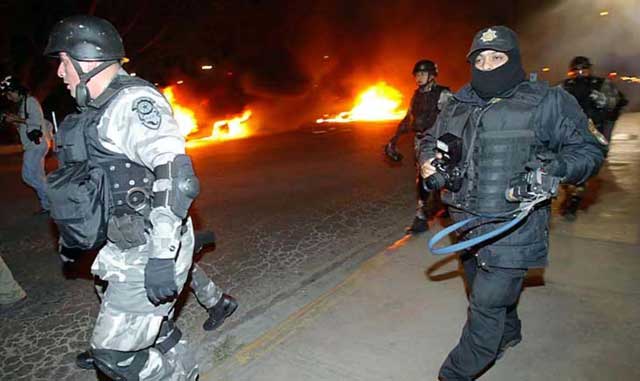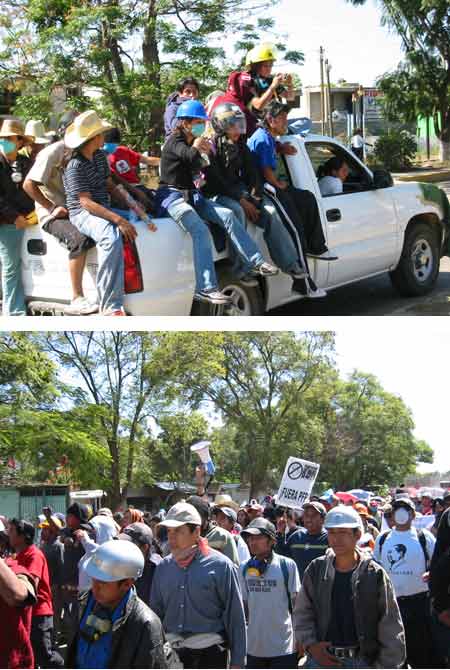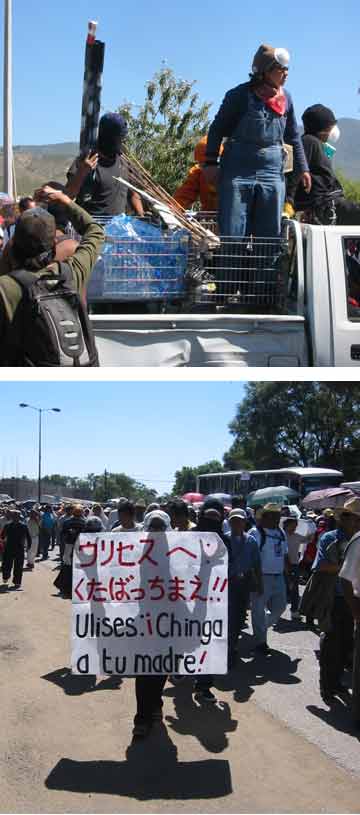
November 2006

Federal Preventive Police go hunting for APPO supporters on night of November 25.
(Photo: José Luis Plata/Reforma)
 By
Abram Negrete
By
Abram NegreteScenes
from the November 25 march before it was attacked by police.
(Internationalist photos)
Saturday, November 25, began
with the seventh “megamarcha”
through the streets of the city of Oaxaca, many thousands of
people
(50,000?) with obvious mass support from the populace lining the
streets and
repeatedly applauding the demonstrators. Some activists believed
it would
have been even bigger were it not for the “disappearance” the previous
night
(by the cops) of two key leaders of the movement, which discouraged
some people
from going. There were also roadblocks on the main highways leading
into town
and buses from the key Valles Centrales region were reportedly shut
down, preventing
many APPO supporters from joining in.
Among those participating in
the march
were teachers from Oaxaca city, the Costa Chica and many other areas.
Some
spoke to each other in Zapotec and other indigenous languages. There
was a
large contingent of health workers, who at one pointed chanted that if
Ulises
Ruiz was dying, they would give up the Hippocratic oath [to do
everything to
aid the sick] and let him die. A large number of community
organizations and
student groups had banners and signs. The PCM (M-L) had a large
contingent with
many red flags. Many young people were part of the march, but there
were also
many grandmothers and grandfathers. The crowd was markedly plebeian in
its
composition, but there were quite a few professionals and middle-class
people
as well.
A popular
singer, who writes protest songs about the police attacks and other
subjects,
had a special CD of songs dedicated to Brad Will. A group of five
indigenous women teachers from the town of Ocotlán asked me to
send their
personal greetings to the family of Brad Will, whom they knew. They
said he was
“always with us in our mobilizations.” They were very happy to hear
that Brad’s
sisters supported their struggle.
Very
interesting was the morale of young people from the barricades,
especially the
Barricada de Cinco Señores (an intersection), which was key
in defeating
the Federal Preventive Police (PFP) attack on the Oaxaca University at
the
beginning of the month. A young man who worked at a
hotel mentioned that “people from many surrounding villages,
little kids,
grandmothers, great-grandmothers, came rushing into town in response to
the
call to defend the University [on November 2]” and were key to
defeating that
police attack.
 After this
Saturday’s demonstration reached the city center, things got “tense”
but then
turned into the worst situation in Oaxaca since the beginning of the
mass
protests seven months ago. As we walked down a street near the bus
station, I looked at the night sky, noticing that the moon was obscured
by what
I thought was a cloud. It was an enormous cloud of tear gas and smoke
from
burning buildings. Soon we found out that over APPO Radio the
organizers of
that day’s huge march were calling on everyone to seek refuge in houses
or
offices because the PFP was sweeping through the streets carrying
out
arrests.
After this
Saturday’s demonstration reached the city center, things got “tense”
but then
turned into the worst situation in Oaxaca since the beginning of the
mass
protests seven months ago. As we walked down a street near the bus
station, I looked at the night sky, noticing that the moon was obscured
by what
I thought was a cloud. It was an enormous cloud of tear gas and smoke
from
burning buildings. Soon we found out that over APPO Radio the
organizers of
that day’s huge march were calling on everyone to seek refuge in houses
or
offices because the PFP was sweeping through the streets carrying
out
arrests.
Already
earlier as protesters marched into the city center, PFP tanquetas
(armored vehicles) lined side streets. Many of the protestors gathered
in and
near the Santo Domingo Plaza, watching the ranks of PFP cops with their
visored
helmets, black body armor, shields, toletes (clubs), teargas
grenade
launchers and other weapons.
Now
police were attacking marchers. They shot teargas
canisters and some
live ammunition, and chased demonstrators as well as journalists (some
of whom
were injured), beating them with extreme violence. Soon the
cops dismantled
and pulverized the main APPO barricade in the city center. Buses out of
the
city were cancelled, and plainclothes cops invaded the bus station,
smashed it
up and drove out those inside.
APPO Radio was
being jammed by the police, with a couple of bars of a rock
song
repeated over and over. You could still hear the announcers if you
moved the
radio around some (later the jamming blotted their voices out
entirely). They
reported that the cops, mainly in plainclothes were making raids and
searching
house to house. “La Doctora Berta,” one of the most popular announcers,
said a
price had been put on her head. Supporters of the PRI (party of Oaxaca
Governor
Ulises Ruiz) had been called on to arm themselves and participate in
the raids.
Red Cross
ambulances on the streets actually had PFP cops in them instead of
medical
personnel. (Someone later told me he had seen two pick-ups filled with
what he
believed were plainclothes cops, wearing bandannas to look like
protestors,
zooming by earlier.) The ultra-right pirate radio station known by
demonstrators as Radio Alcantarilla [“sewer radio”] was calling on
citizens to
report foreigners and “strange-looking people” so they could be taken
to a Ministerio
Publico (special court). Calls to that station were coming in giving
the names
and locations of APPO supporters to be seized. The governor repeatedly
blamed
“outside” leftists, “criminals” and foreigners for the events.
Downtown
buildings (the local court, hotel association and others) had been set
on fire.
Small groups came past the place where we had taken refuge. Many
had the
homemade gas masks (a surgical mask with a sanitary napkin inside,
soaked in
vinegar) that were distributed by the brigades of health workers who,
in an
example of the impressive degree of organization of the protestors, had
gathered at corners in the city center. They discussed whether the
buildings
were set on fire by some young protestors in response to the police
attacks, or
by provocateurs. “We Oaxaquenos defend ourselves, but we are not
vandals,” a
middle-aged woman said.
A European
photographer who had been part of a group chased through the streets by
cops
(his partner had his foot broken when a gas grenade was fired at him)
told of
an older lady in a flowered hat who said “this is dangerous for you”
and the
next minute told protestors where there was a pile of rocks they could
use to
defend themselves against the police.
Rightists
smashed a pickup truck into the office of one of the main APPO leaders,
Flavio
Sosa’s Nueva Izquierda de Oaxaca, which had 14 people inside (one of
whom was
reportedly “disappeared”), drenched the office with gasoline and burned
it
down. The APPO is reporting three dead (this has yet to be confirmed),
more
than 100 wounded (25 by bullets), 25 “disappeared.” The number of
reported arrested
ranges from 140 to 160; twenty had reportedly been formally charged as
of late on
November 27. The Mexican League for the Defense of Human Rights put out
a
detailed chronology of how the PFP started the attack by shooting
teargas and
projectiles from rooftops. The APPO reported that 9 mm and .38 special
bullet
cartridges were recovered from areas where the police fired on
demonstrators.
The papers report that some protest leaders believe the army may be
sent in
P.S. On Sunday morning helicopters were hovering over the ADO bus station. They were flying so low that they shook telephone cables along the street, whose vibration made an eery noise. Pro-government radio stations broadcast the governor's claims that everything was under control, together with the continued calls for delaciones (turning people in to be arrested). Graffiti supporting the APPO and the protests had been painted over by municipal work crews during the night; in some places the white paint was still fresh and sticky to the touch. Graffiti supporting Ulises Ruiz was on the walls in some areas, as were posters saying "Ulises, We Genuine Oaxaca Citizens Are Unanimously Behind You.” Over breakfast a middle-class woman talked to her son about the reporter whose foot was broken by a teargas grenade. “They shouldn't shoot those at people,” she said.” He replied, “If we're talking about ‘should,’ they shouldn’t shoot them at all, they shouldn’t be here, and they shouldn’t exist.” n
Oaxaca Is Burning (10 November 2006)
A Oaxaca Commune? (10 November 2006)
To contact the Internationalist Group and the League for the Fourth International, send e-mail to: internationalistgroup@msn.com